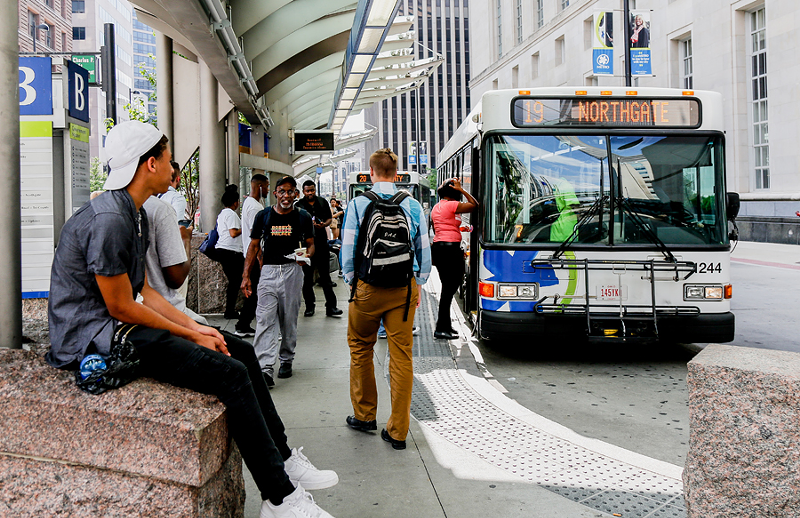The Southwest Ohio Regional Transit Authority yesterday unveiled plans it says could dramatically improve bus service across Cincinnati and Hamilton County.
But there’s a cost — and the higher the price, the better the improvement will be, SORTA says. The transit authority is poised to present county voters with a sales tax levy next year that, under state law, could range anywhere from .5 percent to 1 percent. That money would go toward shoring up the region’s struggling Metro bus system.
“This is a critical time for our community’s public transportation system," Metro CEO and General Manager Dwight A. Ferrell said. "We’re talking about setting up our riders for the future. Metro is excited about the options we’re bringing to the public and look forward to letting the community decide.”
The .5 percent tax — the plan supported by Mayor John Cranley during his reelection bid — would result in bus service staying the same due to coming deficits and looming needs for the system.
But with a .6 percent or .8 percent sales tax increase, Metro says it could expand access for people with disabilities, add new crosstown and circulator job access routes, increase the frequency and hours of weekday and weekend service on existing routes — including 24 hour service on major routes — extend some routes further into the county, and, if voters pony up for the .8 percent increase, even provide some so-called bus rapid transit. Those are routes that mimic light rail with dedicated lanes and fewer stops, speeding up commute times.
All of those projections assume that the .3 percent city earnings tax currently providing some $56 million in funding for Metro goes to other things or is done away with. It also assumes that fares will go up -- slightly at first over the next few years and then as high as $2.40 within a decade. Metro is already considering a boost to $1.90 per Zone 1 ride next year.
Metro says the plan, released yesterday at SORTA’s board meeting, has been three years in the making and incorporates extensive public feedback.
“Now that we have collected valuable feedback and data,” SORTA Board Chair Jason Dunn said, “our next steps are to engage and have a dialogue with our riders and the public to determine the future of Metro and to build community coalitions to successfully achieve meaningful change in 2018.”
Cincinnati’s bus system continues to face big financial challenges. Though a $98.1 million 2018 budget SORTA’s board released earlier this month narrowly avoids deficits, Metro faces a $188 million shortfall over the next decade under current funding conditions.
Metro, which provided 15 million rides last year, has already planned on reductions and restructuring of several routes to save money. Service on Routes 1, 28, 29x, 32, and 49 will be reduced in various ways starting Dec. 3. Changes to those lesser-used routes are expected to save about $500,000 a year.
And that’s just to keep the status quo. An independent report released by consultants AECOM in January found Metro would need at least $1 billion in upgrades over the next 10 years to make it more functional and get more county residents to the region’s jobs.
A 2015 study of Metro’s reach commissioned by the Cincinnati USA Regional Chamber, the Urban Land Institute and other organizations found that only 23 percent of jobs in the city are easily reachable by public transit. Many others take more than 90 minutes to reach by bus.
And about 40 percent of jobs in the city — some 75,000 — aren’t reachable by transit at all. All told, the city ranks lower than 11 other peer cities when it comes to job accessibility via public transit, including regional neighbors Louisville, Indianapolis, Cleveland, Columbus and Pittsburgh, as well as cities like Denver and Austin, Texas.
[Read more about Metro's struggles here.]
Ahead of SORTA’s likely tax ask next year, the transit authority board yesterday also voted down a motion by board member Gary Greenberg that would have ended the agency’s control of Cincinnati’s streetcar. Greenberg said that move was necessary in order to ask taxpayers for money for buses.
“The streetcar is a luxury and the bus system is a necessity,” Greenberg said during the meeting, noting that he wasn’t saying the streetcar wasn’t valuable. “Operating the streetcar is a costly distraction.”
The Hamilton County Commission appointed Greenberg back when Republicans controlled that body. Two other county GOP-appointed board members, Ron Mosby and Daniel St. Charles, also voted for the motion. But eight of the 13-member board rejected spinning the streetcar off from SORTA, with some members calling Greenberg’s idea a “distraction.”
SORTA runs the streetcar by overseeing private company Transdev, which handles daily operations. The city pays for the streetcar's operations from separate funds than those used for Metro.






